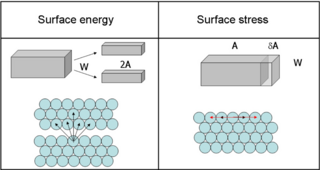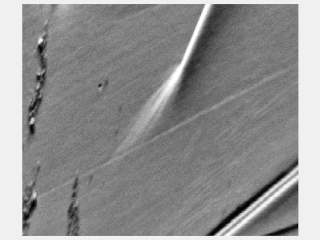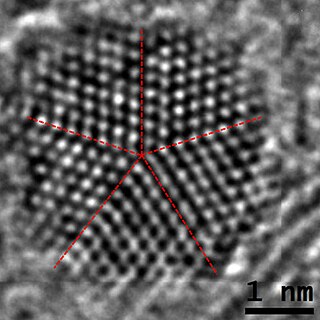
A crystallographic defect is an interruption of the regular patterns of arrangement of atoms or molecules in crystalline solids. The positions and orientations of particles, which are repeating at fixed distances determined by the unit cell parameters in crystals, exhibit a periodic crystal structure, but this is usually imperfect. Several types of defects are often characterized: point defects, line defects, planar defects, bulk defects. Topological homotopy establishes a mathematical method of characterization.

In crystallography, crystal structure is a description of the ordered arrangement of atoms, ions, or molecules in a crystalline material. Ordered structures occur from the intrinsic nature of the constituent particles to form symmetric patterns that repeat along the principal directions of three-dimensional space in matter.
Topological defects or solitons are irregularities or disruptions that occur within continuous fields or ordered states of matter. These defects, which can take various forms such as points, lines, or surfaces, are characterized by their stability and the fact that they cannot be 'smoothed out' or removed through continuous transformations of the field or material. They play a significant role in various areas of physics, including condensed matter physics, cosmology, and quantum field theory, and can have profound effects on the properties and behavior of the systems in which they occur.

In materials science, a dislocation or Taylor's dislocation is a linear crystallographic defect or irregularity within a crystal structure that contains an abrupt change in the arrangement of atoms. The movement of dislocations allow atoms to slide over each other at low stress levels and is known as glide or slip. The crystalline order is restored on either side of a glide dislocation but the atoms on one side have moved by one position. The crystalline order is not fully restored with a partial dislocation. A dislocation defines the boundary between slipped and unslipped regions of material and as a result, must either form a complete loop, intersect other dislocations or defects, or extend to the edges of the crystal. A dislocation can be characterised by the distance and direction of movement it causes to atoms which is defined by the Burgers vector. Plastic deformation of a material occurs by the creation and movement of many dislocations. The number and arrangement of dislocations influences many of the properties of materials.

Nanomaterials describe, in principle, materials of which a single unit is sized between 1 and 100 nm.

A nanoparticle or ultrafine particle is a particle of matter 1 to 100 nanometres (nm) in diameter. The term is sometimes used for larger particles, up to 500 nm, or fibers and tubes that are less than 100 nm in only two directions. At the lowest range, metal particles smaller than 1 nm are usually called atom clusters instead.

Tantalum carbides (TaC) form a family of binary chemical compounds of tantalum and carbon with the empirical formula TaCx, where x usually varies between 0.4 and 1. They are extremely hard, brittle, refractory ceramic materials with metallic electrical conductivity. They appear as brown-gray powders, which are usually processed by sintering.

Crystal twinning occurs when two or more adjacent crystals of the same mineral are oriented so that they share some of the same crystal lattice points in a symmetrical manner. The result is an intergrowth of two separate crystals that are tightly bonded to each other. The surface along which the lattice points are shared in twinned crystals is called a composition surface or twin plane.

In materials science and engineering, the yield point is the point on a stress-strain curve that indicates the limit of elastic behavior and the beginning of plastic behavior. Below the yield point, a material will deform elastically and will return to its original shape when the applied stress is removed. Once the yield point is passed, some fraction of the deformation will be permanent and non-reversible and is known as plastic deformation.
Diffraction topography is a imaging technique based on Bragg diffraction. Diffraction topographic images ("topographies") record the intensity profile of a beam of X-rays diffracted by a crystal. A topography thus represents a two-dimensional spatial intensity mapping (image) of the X-rays diffracted in a specific direction, so regions which diffract substantially will appear brighter than those which do not. This is equivalent to the spatial fine structure of a Laue reflection. Topographs often reveal the irregularities in a non-ideal crystal lattice. X-ray diffraction topography is one variant of X-ray imaging, making use of diffraction contrast rather than absorption contrast which is usually used in radiography and computed tomography (CT). Topography is exploited to a lesser extends with neutrons, and is the same concept as dark field imaging in an electron microscope.
Strain engineering refers to a general strategy employed in semiconductor manufacturing to enhance device performance. Performance benefits are achieved by modulating strain, as one example, in the transistor channel, which enhances electron mobility and thereby conductivity through the channel. Another example are semiconductor photocatalysts strain-engineered for more effective use of sunlight.
The hexatic phase is a state of matter that is between the solid and the isotropic liquid phases in two dimensional systems of particles. It is characterized by two order parameters: a short-range positional and a quasi-long-range orientational (sixfold) order. More generally, a hexatic is any phase that contains sixfold orientational order, in analogy with the nematic phase.

Surface stress was first defined by Josiah Willard Gibbs (1839–1903) as the amount of the reversible work per unit area needed to elastically stretch a pre-existing surface. Depending upon the convention used, the area is either the original, unstretched one which represents a constant number of atoms, or sometimes is the final area; these are atomistic versus continuum definitions. Some care is needed to ensure that the definition used is also consistent with the elastic strain energy, and misinterpretations and disagreements have occurred in the literature.
In quantum many-body physics, topological degeneracy is a phenomenon in which the ground state of a gapped many-body Hamiltonian becomes degenerate in the limit of large system size such that the degeneracy cannot be lifted by any local perturbations.

Nanoparticles are classified as having at least one of its dimensions in the range of 1-100 nanometers (nm). The small size of nanoparticles allows them to have unique characteristics which may not be possible on the macro-scale. Self-assembly is the spontaneous organization of smaller subunits to form larger, well-organized patterns. For nanoparticles, this spontaneous assembly is a consequence of interactions between the particles aimed at achieving a thermodynamic equilibrium and reducing the system’s free energy. The thermodynamics definition of self-assembly was introduced by Professor Nicholas A. Kotov. He describes self-assembly as a process where components of the system acquire non-random spatial distribution with respect to each other and the boundaries of the system. This definition allows one to account for mass and energy fluxes taking place in the self-assembly processes.

An icosahedral twin is a nanostructure appearing in atomic clusters and also nanoparticles with some thousands of atoms. These clusters are twenty-faced, with twenty interlinked tetrahedral crystals joined along triangular faces having three-fold symmetry. A related, more common structure has five units similarly arranged with twinning, which were known as "fivelings" in the 19th century, more recently as "decahedral multiply twinned particles", "pentagonal particles" or "star particles". A variety of different methods lead to the icosahedral form at size scales where surface energies are more important than those from the bulk.

Elżbieta Kossecka is a Polish physicist. She is a professor of technical sciences and a researcher at the Institute of Fundamental Technological Research, Polish Academy of Sciences.
The KTHNY-theory describes the melting of crystals in two dimensions (2D). The name is derived from the initials of the surnames of John Michael Kosterlitz, David J. Thouless, Bertrand Halperin, David R. Nelson, and A. Peter Young, who developed the theory in the 1970s. It is, beside the Ising model in 2D and the XY model in 2D, one of the few theories, which can be solved analytically and which predicts a phase transition at a temperature .

Slip bands or stretcher-strain marks are localized bands of plastic deformation in metals experiencing stresses. Formation of slip bands indicates a concentrated unidirectional slip on certain planes causing a stress concentration. Typically, slip bands induce surface steps and a stress concentration which can be a crack nucleation site. Slip bands extend until impinged by a boundary, and the generated stress from dislocations pile-up against that boundary will either stop or transmit the operating slip depending on its (mis)orientation.

A fiveling, also known as a decahedral nanoparticle, a multiply-twinned particle (MTP), a pentagonal nanoparticle, a pentatwin, or a five-fold twin is a type of twinned crystal that can exist at sizes ranging from nanometers to millimetres. It contains five different single crystals arranged around a common axis. In most cases each unit has a face centered cubic (fcc) arrangement of the atoms, although they are also known for other types of crystal structure.














